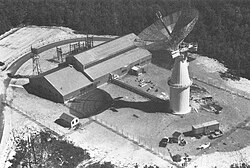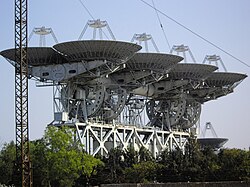
Back علم فلك الرادار Arabic Radarastronomie German Astronomía radar Spanish Radar astronomia Basque اخترشناسی راداری Persian Tutkatähtitiede Finnish Astronomie radar French Réalteolaíocht radair Irish Radarska astronomija Croatian Radar astronomi ID
Radar astronomy is a technique of observing nearby astronomical objects by reflecting radio waves or microwaves off target objects and analyzing their reflections. Radar astronomy differs from radio astronomy in that the latter is a passive observation (i.e., receiving only) and the former an active one (transmitting and receiving). Radar systems have been conducted for six decades applied to a wide range of Solar System studies. The radar transmission may either be pulsed or continuous. The strength of the radar return signal is proportional to the inverse fourth-power of the distance. Upgraded facilities, increased transceiver power, and improved apparatus have increased observational opportunities.
Radar techniques provide information unavailable by other means, such as testing general relativity by observing Mercury[1] and providing a refined value for the astronomical unit.[2] Radar images provide information about the shapes and surface properties of solid bodies, which cannot be obtained by other ground-based techniques.


Relying upon high-powered terrestrial radars (of up to one megawatt),[3] radar astronomy is able to provide extremely accurate astrometric information on the structure, composition and movement of Solar System objects.[4] This aids in forming long-term predictions of asteroid-Earth impacts, as illustrated by the object 99942 Apophis. In particular, optical observations measure where an object appears in the sky, but cannot measure the distance with great accuracy (relying on parallax becomes more difficult when objects are small or poorly illuminated). Radar, on the other hand, directly measures the distance to the object (and how fast it is changing). The combination of optical and radar observations normally allows the prediction of orbits at least decades, and sometimes centuries, into the future.
In August 2020 the Arecibo Observatory (Arecibo Planetary Radar) suffered a structural cable failure, leading to the collapse of the main telescope in December of that year.[5]
There is one remaining radar astronomy facility in regular use, the Goldstone Solar System Radar.
- ^ Anderson, John D.; Slade, Martin A.; Jurgens, Raymond F.; Lau, Eunice L.; Newhall, X. X.; Myles, E. (July 1990). Radar and spacecraft ranging to Mercury between 1966 and 1988. IAU, Asian-Pacific Regional Astronomy Meeting, 5th, Proceedings. Proceedings of the Astronomical Society of Australia (Held July 16–20, 1990). Vol. 9, no. 2. Sydney, Australia: Astronomical Society of Australia. p. 324. Bibcode:1991PASAu...9..324A. ISSN 0066-9997.
- ^ Cite error: The named reference
SP4218was invoked but never defined (see the help page). - ^ "Arecibo Radar Status". Retrieved 22 December 2012.
- ^ Ostro, Steven (1997). "Asteroid Radar Research Page". JPL. Retrieved 22 December 2012.
- ^ "Giant Arecibo radio telescope collapses in Puerto Rico". www.theguardian.com. December 2020. Retrieved March 5, 2021.
© MMXXIII Rich X Search. We shall prevail. All rights reserved. Rich X Search